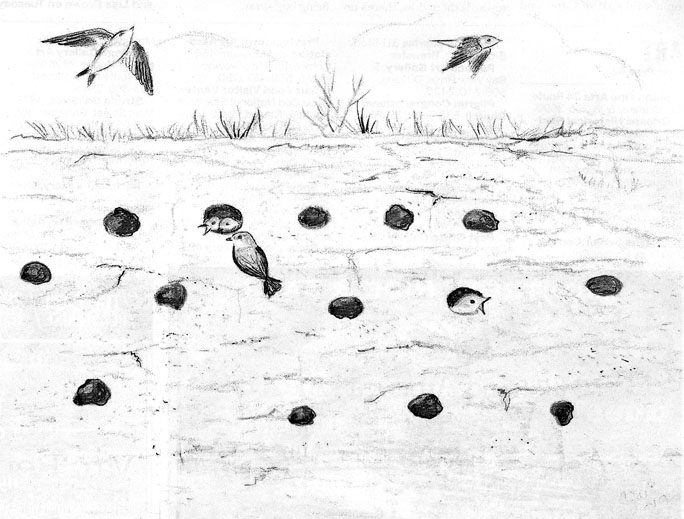
Dear Bird Folks,
Is there a good place to see Bank Swallow nests on Cape Cod?
– Julian, Brewster, MA
Yes, there is, Julian,
Cape Cod has lots of good places to see nesting Bank Swallows, but there are a few things to keep in mind. To start with, by the time you read this, Bank Swallows will have finished nesting for the year, and their babies will have already hatched and flown off. In addition, Bank Swallow nesting areas tend to be ephemeral. (Yes, I have a word-of-the-day calendar.) Unlike, say, Ospreys that will raise their family in the same location year after year, Bank Swallow nest sites tend to be short-lived (aka, ephemeral) and often don’t survive the winter. Therefore, the birds may use new sites each spring, which means we have to search for them.
As their name suggests, Bank Swallows build their nesting burrows in a variety of banks, including riverbanks and sandbanks (but not financial banks…too many hidden fees). Because of storms, erosion and human activity, sand and riverbanks frequently become altered. The birds, which nest in large colonies, must continuously look for suitable sites. One such local site is the Orleans Transfer Station. High above the trucks, cars and dumpsters, sits a very active Bank Swallow colony. It’s a great location because after all, swallows eat flies and if there is something dumps have plenty of, it’s flies.
The dump site was a success, but then I got a phone call from Billy. Billy is a retired guy who spends most of his day driving around looking for cool nature stuff. He told me that hawks had discovered the dump colony and were aggressively picking off the swallows. I was a bit surprised, but Billy knows his stuff, so the next morning I went over to check it out, and he was right. Young Red-tailed Hawks had stationed themselves at the front of the nest burrows. If the adults wanted to enter the burrows, or if the babies wanted to leave, they had to run the hawk gauntlet. I watched for a while, but never saw a single swallow. Had they all been eaten or had most of them escaped and flown away? I wasn’t sure, but I chose to believe the escape version.
When I got back to work and told everyone the bad news, co-worker Amy told me about a Bank Swallow colony she and her boyfriend had found on Eastham’s Coast Guard Beach. I wanted to see it, but it was Fourth of July weekend. I don’t go near any beach on that weekend. Then I remembered the lesson I learned from the plovers in West Dennis. All beaches are birder-friendly…at 5:00AM. I set my alarm.
Parking behind the old Coast Guard station is limited, so I parked at the nearby Doane Rock picnic area. At sunrise, the lot was empty, except for a beat-up old van. I was starting down the trail, when I heard the back of the van clang open and out staggered the world’s best Cheech & Chong impersonator. Whoa! I flashed him the peace sign and kept going. The walk from the parking lot is fairly short and totally worth the effort. The tide was high and the water in Nauset Marsh was mirror calm. A coyote was sniffing in the wet grass along the water’s edge, while a Green Heron hunted in a tidal pool. Farther down the trail, a white-tailed deer was eating some fresh shoots or whatever it is deer eat. I warned it about the coyote, but it didn’t seem to take me seriously. Suit yourself, stubborn white-tail.
Amy told me that the colony was about five minutes north of the swimming area. Walking on the beach used to be fun, but now dragging through soft sand has become difficult. To make things worse, much of the beach was closed off because of nesting shorebirds. I almost had to walk in the water to get by. (Darn birds.) But five minutes later, I arrived at the swallow colony. Bank Swallow colonies can be huge, containing hundreds or even thousands of nests. This one was small. I counted nineteen burrows and only a few were still active. But there wasn’t a hawk in sight, so that was good. The burrows, which the adults dig with their feet, beaks and wings, average two feet long. Whenever a parent arrived with food, it would disappear into the tunnel for a few seconds, before popping back out at full speed.
As I watched the action, I noticed that one adult had stopped going into its burrow. Instead, it flew around the entrance hole. Through my binoculars I could see a baby swallow looking back at me. Awww! Hoping to catch a shot of the mother feeding it, I focused my camera on the entrance. As I clicked away, the mother arrived, but didn’t offer any food; it just hovered. Then, amazingly, the baby leaped into the air to join its mother. Wow! I had witnessed a baby swallow’s first flight. Cool beans! Then, before I could absorb what had just happened, a second baby appeared from deep in the tunnel and it also took to the air for the first time. Double cool beans!
There’s more to this story, but I’ve run out of room. Besides, I’ve forgotten about you, Julian. Here on the Cape, gravel pits, sand cliffs, like the ones on the Outer Cape, and even town dumps are good places to look for Bank Swallows in the spring. By July, the colonies have started to disperse. But whether you see the swallows or not, an early (very early) morning walk on Cape Cod is always rewarding. On my walk I saw baby birds take their first flights, a coyote, a stubborn deer, a Green Heron and the world’s best Cheech & Chong impersonator. Not a bad way to spend a summer morning.